NUR131 Task 2 Student Research Workbook Assignment, Semester 2, 2019
VerifiedAdded on 2022/11/15
|12
|3379
|2
Homework Assignment
AI Summary
This assignment, a student's NUR131 Task 2 Research Workbook from Semester 2, 2019, comprises two main parts: Research Knowledge and Research Critique. The Research Knowledge section evaluates eight research presentations, summarizing their topics and reflecting on their application to future practice. The Research Critique section focuses on an article by Cooke et al. (2018) on consumer perspectives of peripheral intravenous cannulation (PIVC). It includes a detailed analysis of the study's purpose, PICO framework, research design, sampling and recruitment procedures, data collection and analysis methods, and a summary of the study's results, providing a comprehensive overview of the research process and findings.
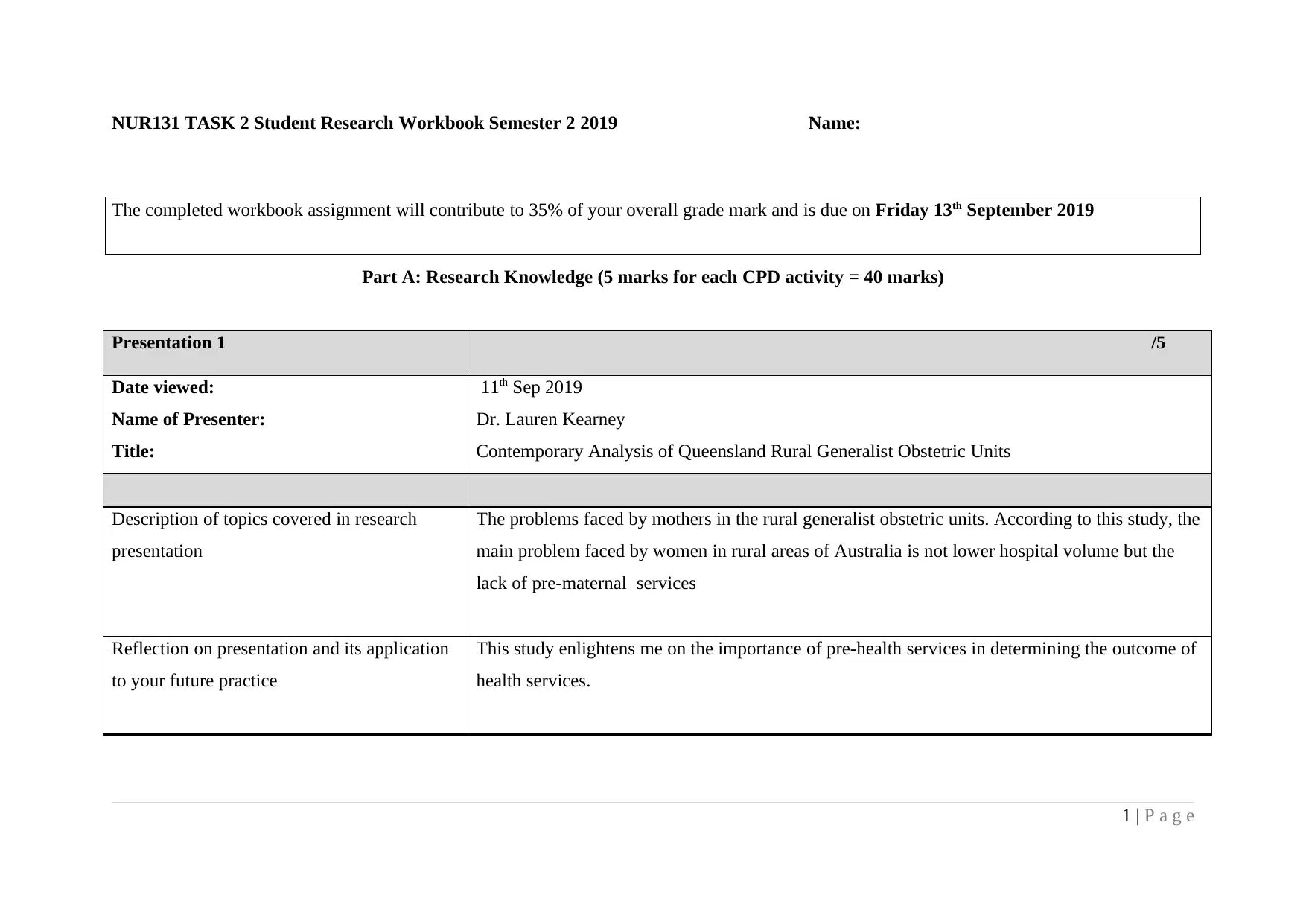
NUR131 TASK 2 Student Research Workbook Semester 2 2019 Name:
The completed workbook assignment will contribute to 35% of your overall grade mark and is due on Friday 13th September 2019
Part A: Research Knowledge (5 marks for each CPD activity = 40 marks)
Presentation 1 /5
Date viewed:
Name of Presenter:
Title:
11th Sep 2019
Dr. Lauren Kearney
Contemporary Analysis of Queensland Rural Generalist Obstetric Units
Description of topics covered in research
presentation
The problems faced by mothers in the rural generalist obstetric units. According to this study, the
main problem faced by women in rural areas of Australia is not lower hospital volume but the
lack of pre-maternal services
Reflection on presentation and its application
to your future practice
This study enlightens me on the importance of pre-health services in determining the outcome of
health services.
1 | P a g e
The completed workbook assignment will contribute to 35% of your overall grade mark and is due on Friday 13th September 2019
Part A: Research Knowledge (5 marks for each CPD activity = 40 marks)
Presentation 1 /5
Date viewed:
Name of Presenter:
Title:
11th Sep 2019
Dr. Lauren Kearney
Contemporary Analysis of Queensland Rural Generalist Obstetric Units
Description of topics covered in research
presentation
The problems faced by mothers in the rural generalist obstetric units. According to this study, the
main problem faced by women in rural areas of Australia is not lower hospital volume but the
lack of pre-maternal services
Reflection on presentation and its application
to your future practice
This study enlightens me on the importance of pre-health services in determining the outcome of
health services.
1 | P a g e
Paraphrase This Document
Need a fresh take? Get an instant paraphrase of this document with our AI Paraphraser

Presentation 2 /5
Date viewed:
Name of Presenter:
Title:
11th Sep 2019
Ann Framp
A narrative inquiry into the experiences of a family predisposed to hereditary gastric cancer
Description of topics covered in research
presentation
The research has covered the topic on hereditary gastric cancer and its effects on the families affected.
It has revealed that any person from a family affected by these mutated genes has an 80% chance of
becoming a victim
Reflection on presentation and its
application to your future practice
From the presentation, I have learnt the importance of ethical considerations in the health profession.
This can be drawn from the fact that Ann had to seek ethical approval before embarking on this study.
Also, I have learnt the importance of patient-centred care in health profession
Presentation 3 /5
Date:
Presenter:
Title:
11th Sep 2019
Roger Carter
Web-Information search practices
Description of topics covered in research
presentation
The study has provided a guide on the best approaches of information search on the internet.
According to it, the results obtained from any information searched depends on the approach of search
Reflection on presentation and its I have learnt the importance of best practices when searching for information on the internet
2 | P a g e
Date viewed:
Name of Presenter:
Title:
11th Sep 2019
Ann Framp
A narrative inquiry into the experiences of a family predisposed to hereditary gastric cancer
Description of topics covered in research
presentation
The research has covered the topic on hereditary gastric cancer and its effects on the families affected.
It has revealed that any person from a family affected by these mutated genes has an 80% chance of
becoming a victim
Reflection on presentation and its
application to your future practice
From the presentation, I have learnt the importance of ethical considerations in the health profession.
This can be drawn from the fact that Ann had to seek ethical approval before embarking on this study.
Also, I have learnt the importance of patient-centred care in health profession
Presentation 3 /5
Date:
Presenter:
Title:
11th Sep 2019
Roger Carter
Web-Information search practices
Description of topics covered in research
presentation
The study has provided a guide on the best approaches of information search on the internet.
According to it, the results obtained from any information searched depends on the approach of search
Reflection on presentation and its I have learnt the importance of best practices when searching for information on the internet
2 | P a g e
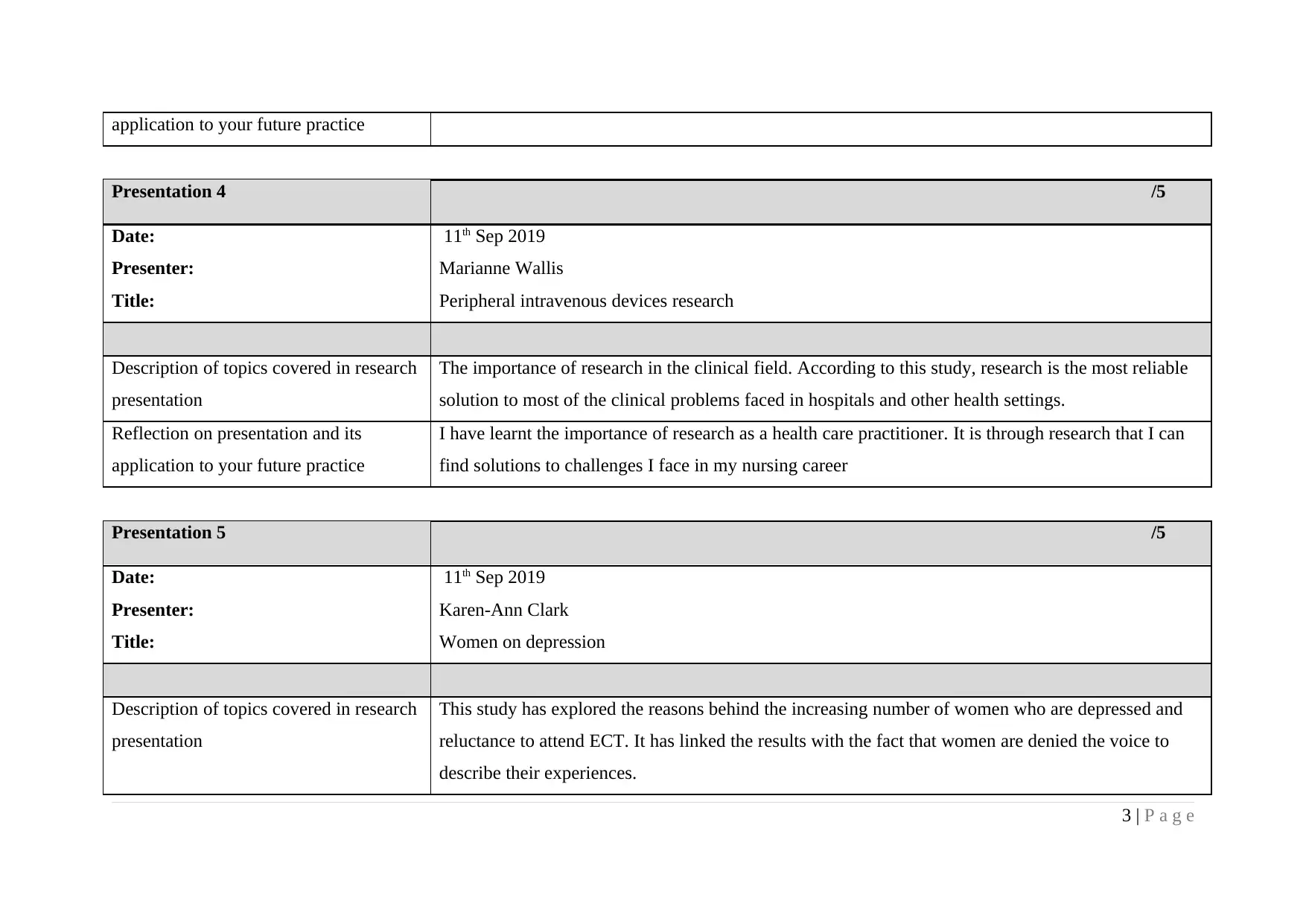
application to your future practice
Presentation 4 /5
Date:
Presenter:
Title:
11th Sep 2019
Marianne Wallis
Peripheral intravenous devices research
Description of topics covered in research
presentation
The importance of research in the clinical field. According to this study, research is the most reliable
solution to most of the clinical problems faced in hospitals and other health settings.
Reflection on presentation and its
application to your future practice
I have learnt the importance of research as a health care practitioner. It is through research that I can
find solutions to challenges I face in my nursing career
Presentation 5 /5
Date:
Presenter:
Title:
11th Sep 2019
Karen-Ann Clark
Women on depression
Description of topics covered in research
presentation
This study has explored the reasons behind the increasing number of women who are depressed and
reluctance to attend ECT. It has linked the results with the fact that women are denied the voice to
describe their experiences.
3 | P a g e
Presentation 4 /5
Date:
Presenter:
Title:
11th Sep 2019
Marianne Wallis
Peripheral intravenous devices research
Description of topics covered in research
presentation
The importance of research in the clinical field. According to this study, research is the most reliable
solution to most of the clinical problems faced in hospitals and other health settings.
Reflection on presentation and its
application to your future practice
I have learnt the importance of research as a health care practitioner. It is through research that I can
find solutions to challenges I face in my nursing career
Presentation 5 /5
Date:
Presenter:
Title:
11th Sep 2019
Karen-Ann Clark
Women on depression
Description of topics covered in research
presentation
This study has explored the reasons behind the increasing number of women who are depressed and
reluctance to attend ECT. It has linked the results with the fact that women are denied the voice to
describe their experiences.
3 | P a g e
⊘ This is a preview!⊘
Do you want full access?
Subscribe today to unlock all pages.

Trusted by 1+ million students worldwide
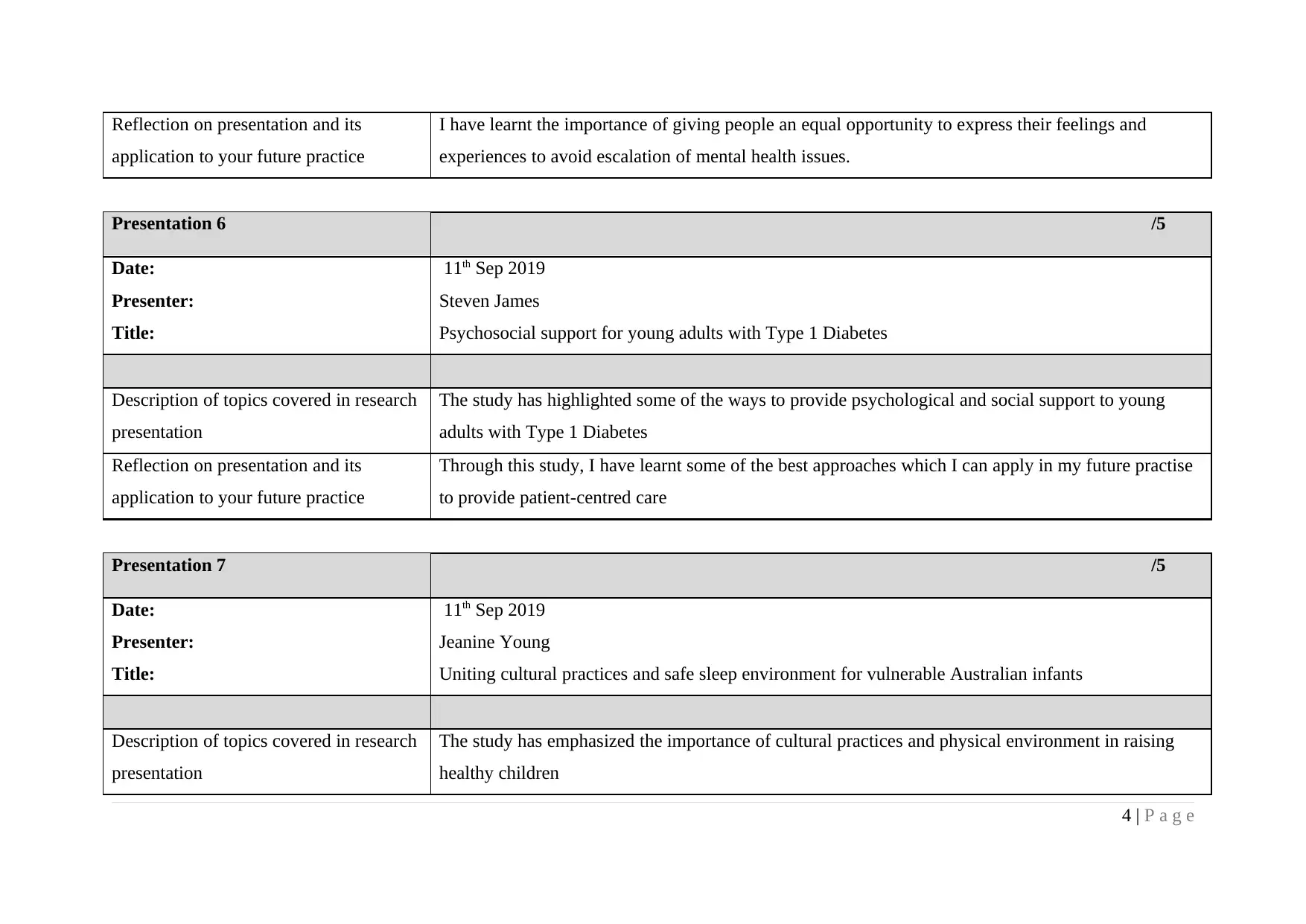
Reflection on presentation and its
application to your future practice
I have learnt the importance of giving people an equal opportunity to express their feelings and
experiences to avoid escalation of mental health issues.
Presentation 6 /5
Date:
Presenter:
Title:
11th Sep 2019
Steven James
Psychosocial support for young adults with Type 1 Diabetes
Description of topics covered in research
presentation
The study has highlighted some of the ways to provide psychological and social support to young
adults with Type 1 Diabetes
Reflection on presentation and its
application to your future practice
Through this study, I have learnt some of the best approaches which I can apply in my future practise
to provide patient-centred care
Presentation 7 /5
Date:
Presenter:
Title:
11th Sep 2019
Jeanine Young
Uniting cultural practices and safe sleep environment for vulnerable Australian infants
Description of topics covered in research
presentation
The study has emphasized the importance of cultural practices and physical environment in raising
healthy children
4 | P a g e
application to your future practice
I have learnt the importance of giving people an equal opportunity to express their feelings and
experiences to avoid escalation of mental health issues.
Presentation 6 /5
Date:
Presenter:
Title:
11th Sep 2019
Steven James
Psychosocial support for young adults with Type 1 Diabetes
Description of topics covered in research
presentation
The study has highlighted some of the ways to provide psychological and social support to young
adults with Type 1 Diabetes
Reflection on presentation and its
application to your future practice
Through this study, I have learnt some of the best approaches which I can apply in my future practise
to provide patient-centred care
Presentation 7 /5
Date:
Presenter:
Title:
11th Sep 2019
Jeanine Young
Uniting cultural practices and safe sleep environment for vulnerable Australian infants
Description of topics covered in research
presentation
The study has emphasized the importance of cultural practices and physical environment in raising
healthy children
4 | P a g e
Paraphrase This Document
Need a fresh take? Get an instant paraphrase of this document with our AI Paraphraser
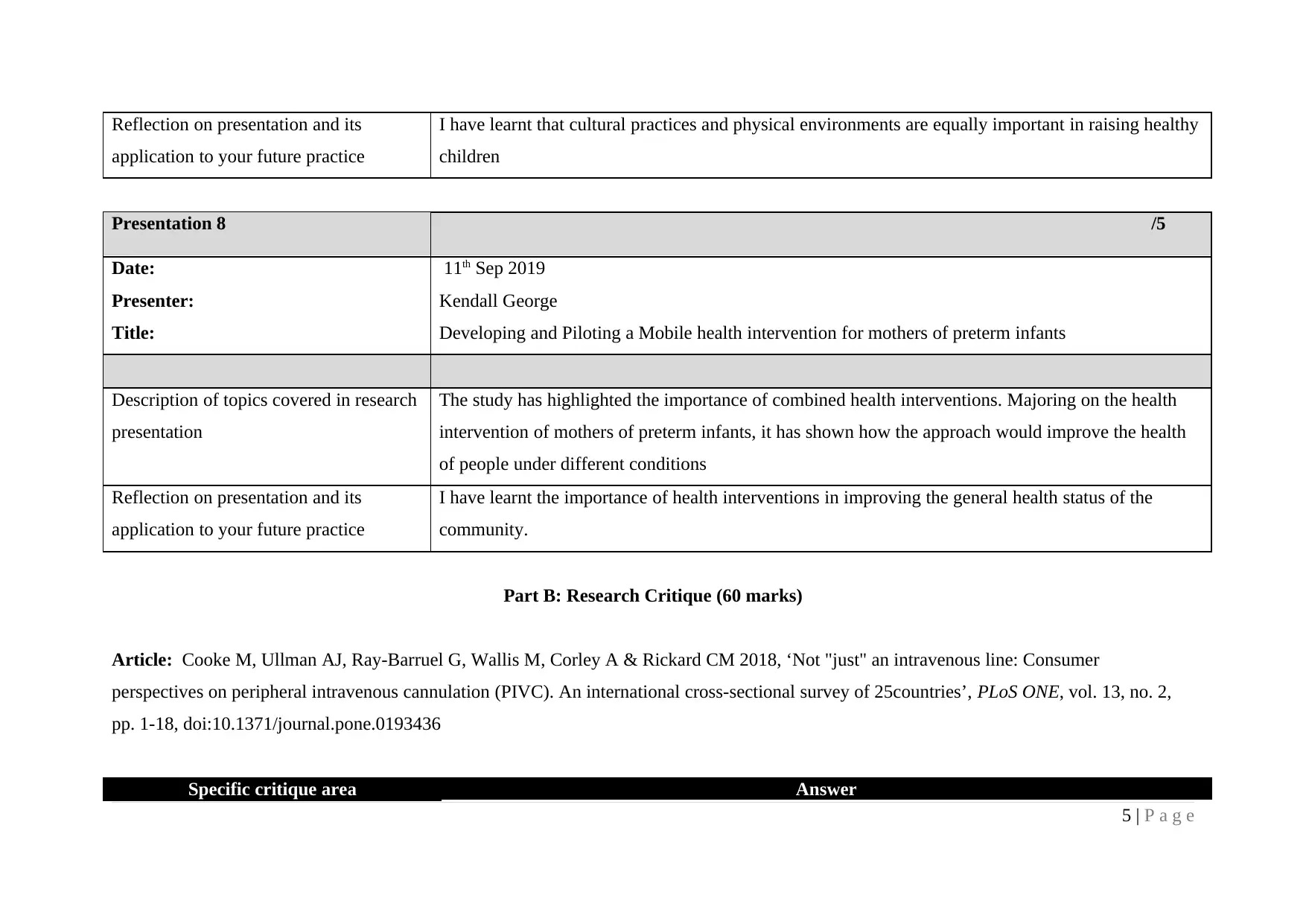
Reflection on presentation and its
application to your future practice
I have learnt that cultural practices and physical environments are equally important in raising healthy
children
Presentation 8 /5
Date:
Presenter:
Title:
11th Sep 2019
Kendall George
Developing and Piloting a Mobile health intervention for mothers of preterm infants
Description of topics covered in research
presentation
The study has highlighted the importance of combined health interventions. Majoring on the health
intervention of mothers of preterm infants, it has shown how the approach would improve the health
of people under different conditions
Reflection on presentation and its
application to your future practice
I have learnt the importance of health interventions in improving the general health status of the
community.
Part B: Research Critique (60 marks)
Article: Cooke M, Ullman AJ, Ray-Barruel G, Wallis M, Corley A & Rickard CM 2018, ‘Not "just" an intravenous line: Consumer
perspectives on peripheral intravenous cannulation (PIVC). An international cross-sectional survey of 25countries’, PLoS ONE, vol. 13, no. 2,
pp. 1-18, doi:10.1371/journal.pone.0193436
Specific critique area Answer
5 | P a g e
application to your future practice
I have learnt that cultural practices and physical environments are equally important in raising healthy
children
Presentation 8 /5
Date:
Presenter:
Title:
11th Sep 2019
Kendall George
Developing and Piloting a Mobile health intervention for mothers of preterm infants
Description of topics covered in research
presentation
The study has highlighted the importance of combined health interventions. Majoring on the health
intervention of mothers of preterm infants, it has shown how the approach would improve the health
of people under different conditions
Reflection on presentation and its
application to your future practice
I have learnt the importance of health interventions in improving the general health status of the
community.
Part B: Research Critique (60 marks)
Article: Cooke M, Ullman AJ, Ray-Barruel G, Wallis M, Corley A & Rickard CM 2018, ‘Not "just" an intravenous line: Consumer
perspectives on peripheral intravenous cannulation (PIVC). An international cross-sectional survey of 25countries’, PLoS ONE, vol. 13, no. 2,
pp. 1-18, doi:10.1371/journal.pone.0193436
Specific critique area Answer
5 | P a g e
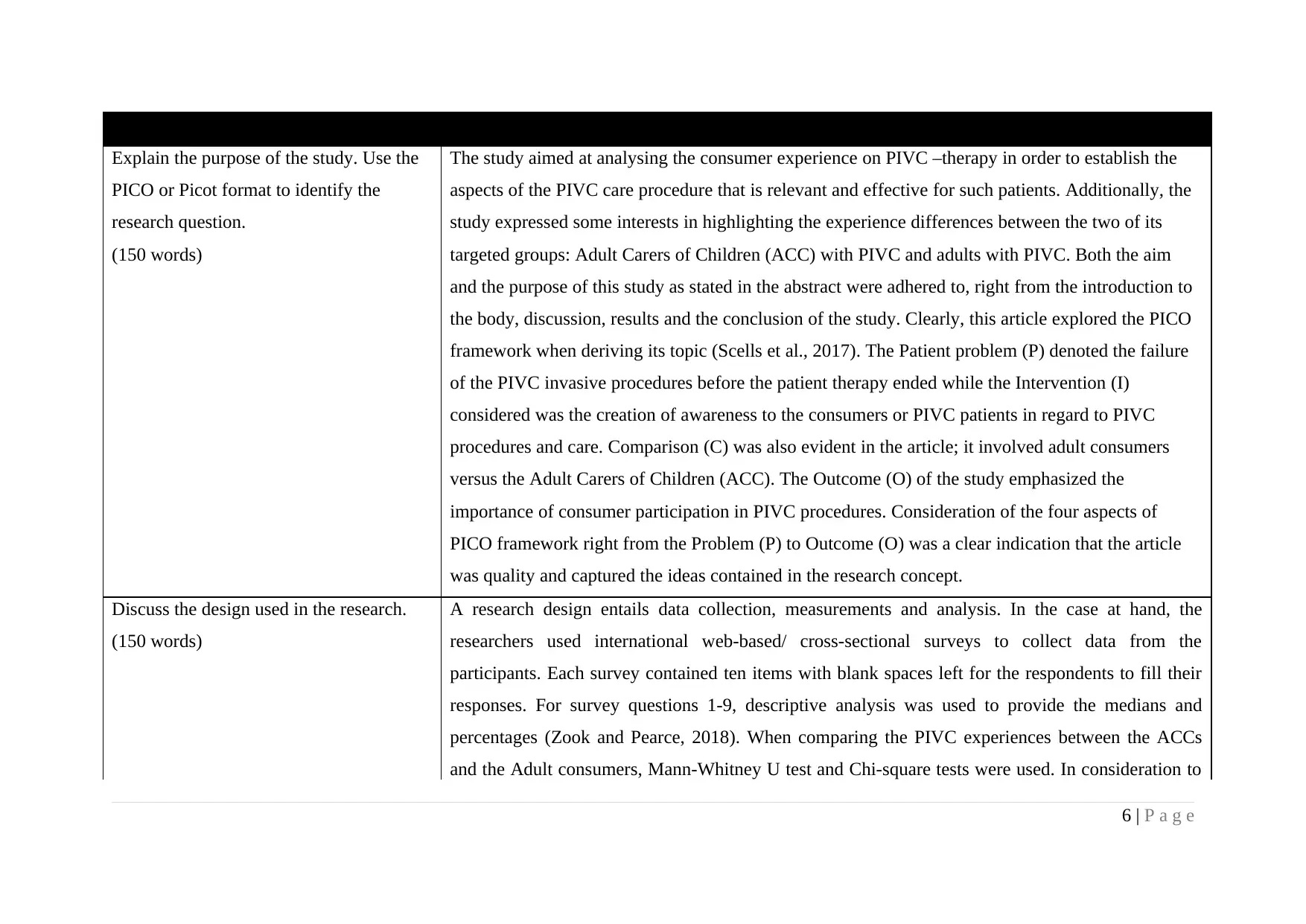
Explain the purpose of the study. Use the
PICO or Picot format to identify the
research question.
(150 words)
The study aimed at analysing the consumer experience on PIVC –therapy in order to establish the
aspects of the PIVC care procedure that is relevant and effective for such patients. Additionally, the
study expressed some interests in highlighting the experience differences between the two of its
targeted groups: Adult Carers of Children (ACC) with PIVC and adults with PIVC. Both the aim
and the purpose of this study as stated in the abstract were adhered to, right from the introduction to
the body, discussion, results and the conclusion of the study. Clearly, this article explored the PICO
framework when deriving its topic (Scells et al., 2017). The Patient problem (P) denoted the failure
of the PIVC invasive procedures before the patient therapy ended while the Intervention (I)
considered was the creation of awareness to the consumers or PIVC patients in regard to PIVC
procedures and care. Comparison (C) was also evident in the article; it involved adult consumers
versus the Adult Carers of Children (ACC). The Outcome (O) of the study emphasized the
importance of consumer participation in PIVC procedures. Consideration of the four aspects of
PICO framework right from the Problem (P) to Outcome (O) was a clear indication that the article
was quality and captured the ideas contained in the research concept.
Discuss the design used in the research.
(150 words)
A research design entails data collection, measurements and analysis. In the case at hand, the
researchers used international web-based/ cross-sectional surveys to collect data from the
participants. Each survey contained ten items with blank spaces left for the respondents to fill their
responses. For survey questions 1-9, descriptive analysis was used to provide the medians and
percentages (Zook and Pearce, 2018). When comparing the PIVC experiences between the ACCs
and the Adult consumers, Mann-Whitney U test and Chi-square tests were used. In consideration to
6 | P a g e
PICO or Picot format to identify the
research question.
(150 words)
The study aimed at analysing the consumer experience on PIVC –therapy in order to establish the
aspects of the PIVC care procedure that is relevant and effective for such patients. Additionally, the
study expressed some interests in highlighting the experience differences between the two of its
targeted groups: Adult Carers of Children (ACC) with PIVC and adults with PIVC. Both the aim
and the purpose of this study as stated in the abstract were adhered to, right from the introduction to
the body, discussion, results and the conclusion of the study. Clearly, this article explored the PICO
framework when deriving its topic (Scells et al., 2017). The Patient problem (P) denoted the failure
of the PIVC invasive procedures before the patient therapy ended while the Intervention (I)
considered was the creation of awareness to the consumers or PIVC patients in regard to PIVC
procedures and care. Comparison (C) was also evident in the article; it involved adult consumers
versus the Adult Carers of Children (ACC). The Outcome (O) of the study emphasized the
importance of consumer participation in PIVC procedures. Consideration of the four aspects of
PICO framework right from the Problem (P) to Outcome (O) was a clear indication that the article
was quality and captured the ideas contained in the research concept.
Discuss the design used in the research.
(150 words)
A research design entails data collection, measurements and analysis. In the case at hand, the
researchers used international web-based/ cross-sectional surveys to collect data from the
participants. Each survey contained ten items with blank spaces left for the respondents to fill their
responses. For survey questions 1-9, descriptive analysis was used to provide the medians and
percentages (Zook and Pearce, 2018). When comparing the PIVC experiences between the ACCs
and the Adult consumers, Mann-Whitney U test and Chi-square tests were used. In consideration to
6 | P a g e
⊘ This is a preview!⊘
Do you want full access?
Subscribe today to unlock all pages.

Trusted by 1+ million students worldwide
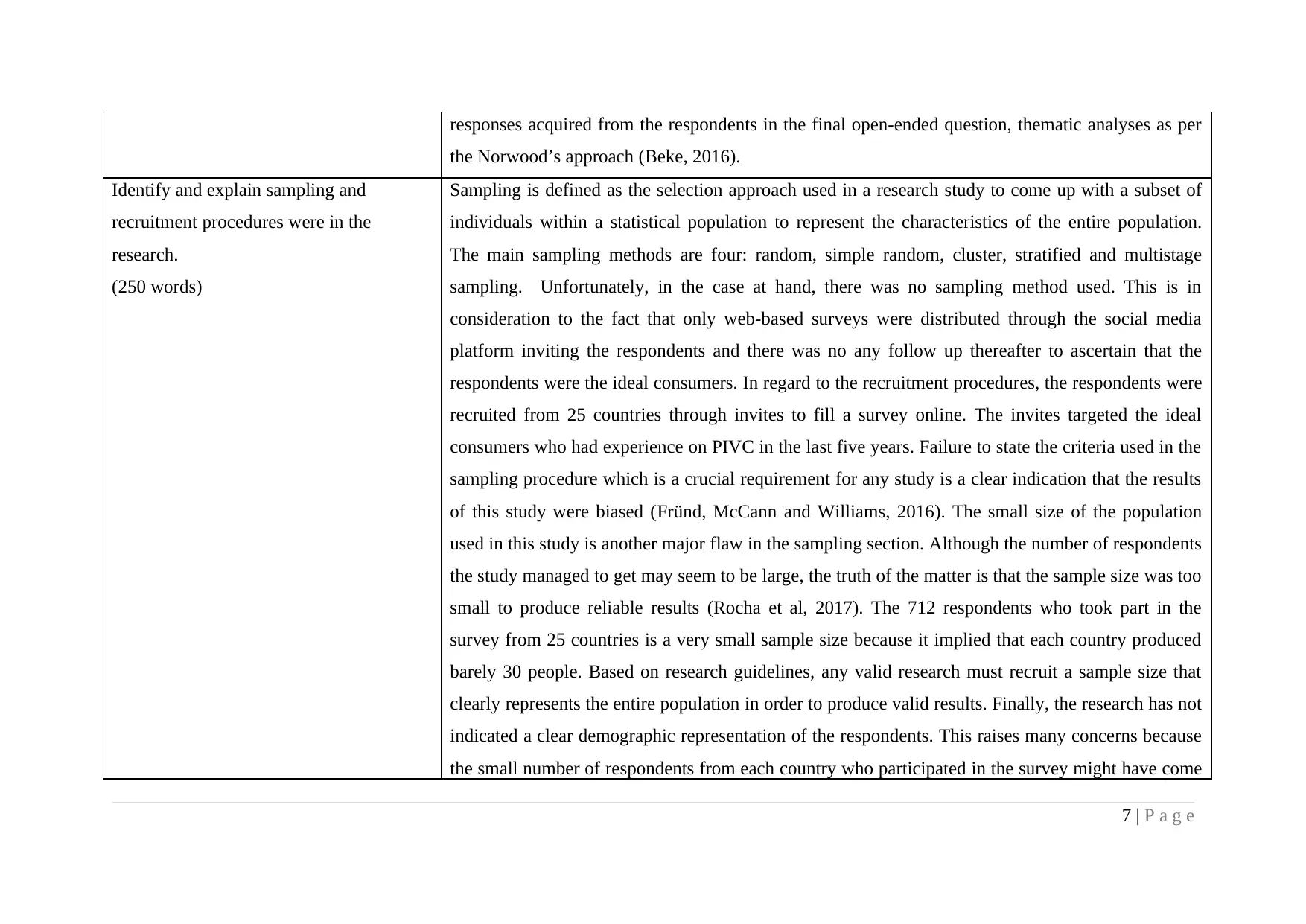
responses acquired from the respondents in the final open-ended question, thematic analyses as per
the Norwood’s approach (Beke, 2016).
Identify and explain sampling and
recruitment procedures were in the
research.
(250 words)
Sampling is defined as the selection approach used in a research study to come up with a subset of
individuals within a statistical population to represent the characteristics of the entire population.
The main sampling methods are four: random, simple random, cluster, stratified and multistage
sampling. Unfortunately, in the case at hand, there was no sampling method used. This is in
consideration to the fact that only web-based surveys were distributed through the social media
platform inviting the respondents and there was no any follow up thereafter to ascertain that the
respondents were the ideal consumers. In regard to the recruitment procedures, the respondents were
recruited from 25 countries through invites to fill a survey online. The invites targeted the ideal
consumers who had experience on PIVC in the last five years. Failure to state the criteria used in the
sampling procedure which is a crucial requirement for any study is a clear indication that the results
of this study were biased (Fründ, McCann and Williams, 2016). The small size of the population
used in this study is another major flaw in the sampling section. Although the number of respondents
the study managed to get may seem to be large, the truth of the matter is that the sample size was too
small to produce reliable results (Rocha et al, 2017). The 712 respondents who took part in the
survey from 25 countries is a very small sample size because it implied that each country produced
barely 30 people. Based on research guidelines, any valid research must recruit a sample size that
clearly represents the entire population in order to produce valid results. Finally, the research has not
indicated a clear demographic representation of the respondents. This raises many concerns because
the small number of respondents from each country who participated in the survey might have come
7 | P a g e
the Norwood’s approach (Beke, 2016).
Identify and explain sampling and
recruitment procedures were in the
research.
(250 words)
Sampling is defined as the selection approach used in a research study to come up with a subset of
individuals within a statistical population to represent the characteristics of the entire population.
The main sampling methods are four: random, simple random, cluster, stratified and multistage
sampling. Unfortunately, in the case at hand, there was no sampling method used. This is in
consideration to the fact that only web-based surveys were distributed through the social media
platform inviting the respondents and there was no any follow up thereafter to ascertain that the
respondents were the ideal consumers. In regard to the recruitment procedures, the respondents were
recruited from 25 countries through invites to fill a survey online. The invites targeted the ideal
consumers who had experience on PIVC in the last five years. Failure to state the criteria used in the
sampling procedure which is a crucial requirement for any study is a clear indication that the results
of this study were biased (Fründ, McCann and Williams, 2016). The small size of the population
used in this study is another major flaw in the sampling section. Although the number of respondents
the study managed to get may seem to be large, the truth of the matter is that the sample size was too
small to produce reliable results (Rocha et al, 2017). The 712 respondents who took part in the
survey from 25 countries is a very small sample size because it implied that each country produced
barely 30 people. Based on research guidelines, any valid research must recruit a sample size that
clearly represents the entire population in order to produce valid results. Finally, the research has not
indicated a clear demographic representation of the respondents. This raises many concerns because
the small number of respondents from each country who participated in the survey might have come
7 | P a g e
Paraphrase This Document
Need a fresh take? Get an instant paraphrase of this document with our AI Paraphraser

from the same regions.
Explain how the data was collected.
(200 words)
The researchers used international web-based/ cross-sectional surveys to collect data from the
participants. Web-based surveys are types of surveys which involve self-administered electronic
questions on the web. In the article under discussion, the questions were posed in the social media
platforms such as Facebook, Instagram, LinkedIn and Imo targeting the users of those platforms
(Revilla et al, 2016). According to the article, each survey contained ten items with blank spaces left
for the respondents to fill their responses. The surveys were distributed as invites to ideal consumers
of the PIVC procedures in the last five years. To honour data security and privacy in the collection
process, Griffith University’s Survey centre which guaranteed secure storage and transmission
environment. A sheet which contained the details of study participation was posted on the web page
for the targeted respondents to give their responses. Completion of a survey was considered a sign of
respondent consent to take part in the study. Every single survey contained 10 questions which had
been developed form the PIVC topic on different sources and passed through the AVATAR group
which has research and clinical expertise in matters vascular access.
Explain how data was analyzed.
(150 words)
Data analysis is the application of statistics and statistical calculations to organize, represent,
describe, evaluate and interpret data. Different analytical approaches have been used in this article.
For instance, descriptive analysis was used to provide medians and percentages of the survey
questions 1-9. Descriptive analysis is a method of data analysis which describes the basic features of
any data in a study. In the article, it acted as an important step of analysis by giving an idea of the
data distribution, providing a way of detecting typos and outliers and enabling the researchers to
identify the interrelationships between different variables.
8 | P a g e
Explain how the data was collected.
(200 words)
The researchers used international web-based/ cross-sectional surveys to collect data from the
participants. Web-based surveys are types of surveys which involve self-administered electronic
questions on the web. In the article under discussion, the questions were posed in the social media
platforms such as Facebook, Instagram, LinkedIn and Imo targeting the users of those platforms
(Revilla et al, 2016). According to the article, each survey contained ten items with blank spaces left
for the respondents to fill their responses. The surveys were distributed as invites to ideal consumers
of the PIVC procedures in the last five years. To honour data security and privacy in the collection
process, Griffith University’s Survey centre which guaranteed secure storage and transmission
environment. A sheet which contained the details of study participation was posted on the web page
for the targeted respondents to give their responses. Completion of a survey was considered a sign of
respondent consent to take part in the study. Every single survey contained 10 questions which had
been developed form the PIVC topic on different sources and passed through the AVATAR group
which has research and clinical expertise in matters vascular access.
Explain how data was analyzed.
(150 words)
Data analysis is the application of statistics and statistical calculations to organize, represent,
describe, evaluate and interpret data. Different analytical approaches have been used in this article.
For instance, descriptive analysis was used to provide medians and percentages of the survey
questions 1-9. Descriptive analysis is a method of data analysis which describes the basic features of
any data in a study. In the article, it acted as an important step of analysis by giving an idea of the
data distribution, providing a way of detecting typos and outliers and enabling the researchers to
identify the interrelationships between different variables.
8 | P a g e
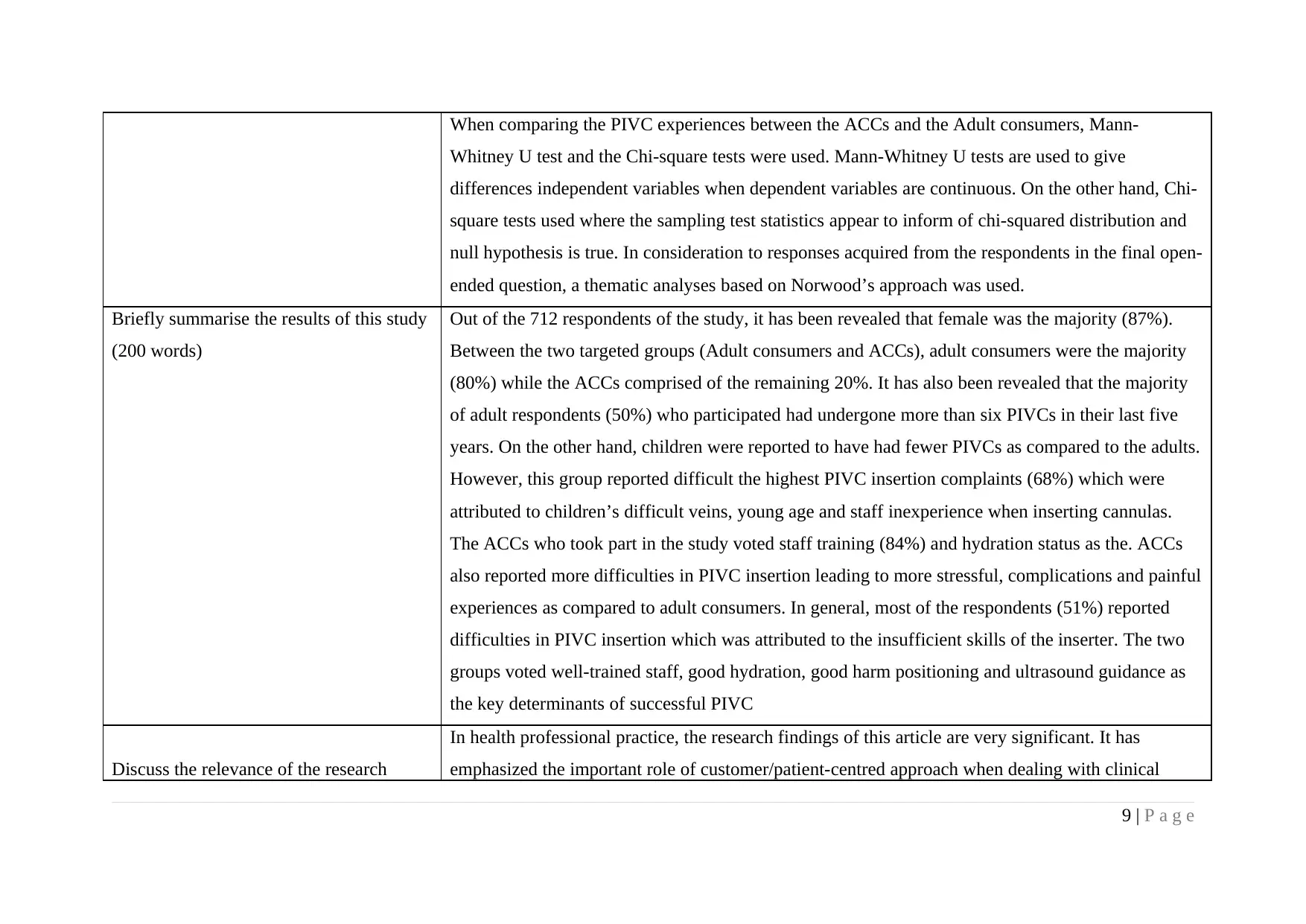
When comparing the PIVC experiences between the ACCs and the Adult consumers, Mann-
Whitney U test and the Chi-square tests were used. Mann-Whitney U tests are used to give
differences independent variables when dependent variables are continuous. On the other hand, Chi-
square tests used where the sampling test statistics appear to inform of chi-squared distribution and
null hypothesis is true. In consideration to responses acquired from the respondents in the final open-
ended question, a thematic analyses based on Norwood’s approach was used.
Briefly summarise the results of this study
(200 words)
Out of the 712 respondents of the study, it has been revealed that female was the majority (87%).
Between the two targeted groups (Adult consumers and ACCs), adult consumers were the majority
(80%) while the ACCs comprised of the remaining 20%. It has also been revealed that the majority
of adult respondents (50%) who participated had undergone more than six PIVCs in their last five
years. On the other hand, children were reported to have had fewer PIVCs as compared to the adults.
However, this group reported difficult the highest PIVC insertion complaints (68%) which were
attributed to children’s difficult veins, young age and staff inexperience when inserting cannulas.
The ACCs who took part in the study voted staff training (84%) and hydration status as the. ACCs
also reported more difficulties in PIVC insertion leading to more stressful, complications and painful
experiences as compared to adult consumers. In general, most of the respondents (51%) reported
difficulties in PIVC insertion which was attributed to the insufficient skills of the inserter. The two
groups voted well-trained staff, good hydration, good harm positioning and ultrasound guidance as
the key determinants of successful PIVC
Discuss the relevance of the research
In health professional practice, the research findings of this article are very significant. It has
emphasized the important role of customer/patient-centred approach when dealing with clinical
9 | P a g e
Whitney U test and the Chi-square tests were used. Mann-Whitney U tests are used to give
differences independent variables when dependent variables are continuous. On the other hand, Chi-
square tests used where the sampling test statistics appear to inform of chi-squared distribution and
null hypothesis is true. In consideration to responses acquired from the respondents in the final open-
ended question, a thematic analyses based on Norwood’s approach was used.
Briefly summarise the results of this study
(200 words)
Out of the 712 respondents of the study, it has been revealed that female was the majority (87%).
Between the two targeted groups (Adult consumers and ACCs), adult consumers were the majority
(80%) while the ACCs comprised of the remaining 20%. It has also been revealed that the majority
of adult respondents (50%) who participated had undergone more than six PIVCs in their last five
years. On the other hand, children were reported to have had fewer PIVCs as compared to the adults.
However, this group reported difficult the highest PIVC insertion complaints (68%) which were
attributed to children’s difficult veins, young age and staff inexperience when inserting cannulas.
The ACCs who took part in the study voted staff training (84%) and hydration status as the. ACCs
also reported more difficulties in PIVC insertion leading to more stressful, complications and painful
experiences as compared to adult consumers. In general, most of the respondents (51%) reported
difficulties in PIVC insertion which was attributed to the insufficient skills of the inserter. The two
groups voted well-trained staff, good hydration, good harm positioning and ultrasound guidance as
the key determinants of successful PIVC
Discuss the relevance of the research
In health professional practice, the research findings of this article are very significant. It has
emphasized the important role of customer/patient-centred approach when dealing with clinical
9 | P a g e
⊘ This is a preview!⊘
Do you want full access?
Subscribe today to unlock all pages.

Trusted by 1+ million students worldwide
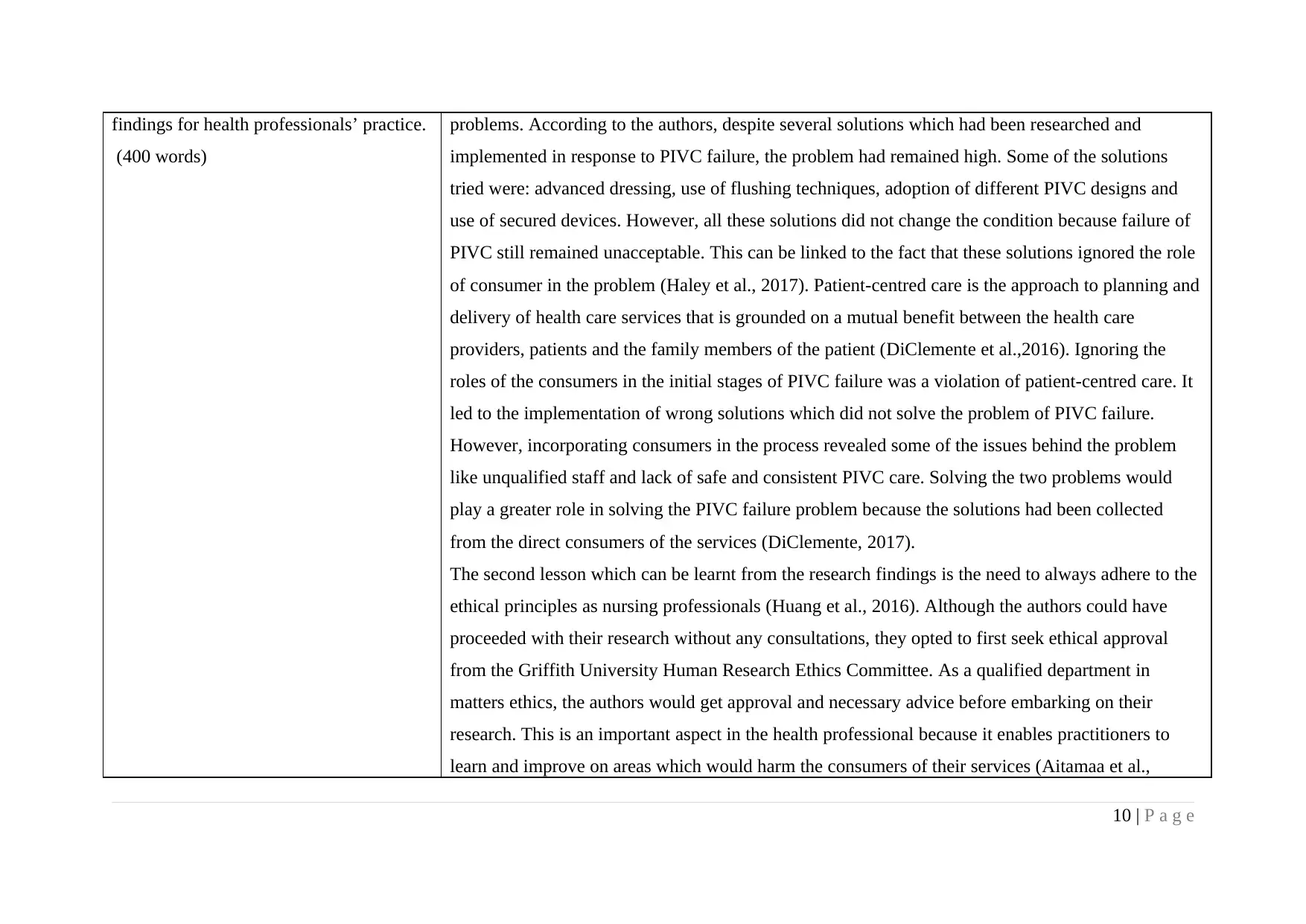
findings for health professionals’ practice.
(400 words)
problems. According to the authors, despite several solutions which had been researched and
implemented in response to PIVC failure, the problem had remained high. Some of the solutions
tried were: advanced dressing, use of flushing techniques, adoption of different PIVC designs and
use of secured devices. However, all these solutions did not change the condition because failure of
PIVC still remained unacceptable. This can be linked to the fact that these solutions ignored the role
of consumer in the problem (Haley et al., 2017). Patient-centred care is the approach to planning and
delivery of health care services that is grounded on a mutual benefit between the health care
providers, patients and the family members of the patient (DiClemente et al.,2016). Ignoring the
roles of the consumers in the initial stages of PIVC failure was a violation of patient-centred care. It
led to the implementation of wrong solutions which did not solve the problem of PIVC failure.
However, incorporating consumers in the process revealed some of the issues behind the problem
like unqualified staff and lack of safe and consistent PIVC care. Solving the two problems would
play a greater role in solving the PIVC failure problem because the solutions had been collected
from the direct consumers of the services (DiClemente, 2017).
The second lesson which can be learnt from the research findings is the need to always adhere to the
ethical principles as nursing professionals (Huang et al., 2016). Although the authors could have
proceeded with their research without any consultations, they opted to first seek ethical approval
from the Griffith University Human Research Ethics Committee. As a qualified department in
matters ethics, the authors would get approval and necessary advice before embarking on their
research. This is an important aspect in the health professional because it enables practitioners to
learn and improve on areas which would harm the consumers of their services (Aitamaa et al.,
10 | P a g e
(400 words)
problems. According to the authors, despite several solutions which had been researched and
implemented in response to PIVC failure, the problem had remained high. Some of the solutions
tried were: advanced dressing, use of flushing techniques, adoption of different PIVC designs and
use of secured devices. However, all these solutions did not change the condition because failure of
PIVC still remained unacceptable. This can be linked to the fact that these solutions ignored the role
of consumer in the problem (Haley et al., 2017). Patient-centred care is the approach to planning and
delivery of health care services that is grounded on a mutual benefit between the health care
providers, patients and the family members of the patient (DiClemente et al.,2016). Ignoring the
roles of the consumers in the initial stages of PIVC failure was a violation of patient-centred care. It
led to the implementation of wrong solutions which did not solve the problem of PIVC failure.
However, incorporating consumers in the process revealed some of the issues behind the problem
like unqualified staff and lack of safe and consistent PIVC care. Solving the two problems would
play a greater role in solving the PIVC failure problem because the solutions had been collected
from the direct consumers of the services (DiClemente, 2017).
The second lesson which can be learnt from the research findings is the need to always adhere to the
ethical principles as nursing professionals (Huang et al., 2016). Although the authors could have
proceeded with their research without any consultations, they opted to first seek ethical approval
from the Griffith University Human Research Ethics Committee. As a qualified department in
matters ethics, the authors would get approval and necessary advice before embarking on their
research. This is an important aspect in the health professional because it enables practitioners to
learn and improve on areas which would harm the consumers of their services (Aitamaa et al.,
10 | P a g e
Paraphrase This Document
Need a fresh take? Get an instant paraphrase of this document with our AI Paraphraser

2016). Also, out of their conscience on the importance of consumer data security and privacy, the
authors opted to use Griffith University Survey Centre in order to ensure that the respondent’s
survey responses will be received in a secure environment. This step was taken without any external
force but the understanding that data security and privacy is important for the respondents.
Therefore, it is a lesson to the healthcare practitioners on the importance of ethics in health care
professional.
References
Aitamaa, E., Leino-Kilpi, H., Iltanen, S. and Suhonen, R., 2016. Ethical problems in nursing management: the views of nurse managers. Nursing
Ethics, 23(6), pp.646-658.
Beke, D.M., 2016. Norwood procedure for palliation of hypoplastic left heart syndrome: right ventricle to pulmonary artery conduit vs modified
Blalock-Taussig shunt. Critical care nurse, 36(6), pp.42-51.
Cooke M, Ullman AJ, Ray-Barruel G, Wallis M, Corley A & Rickard CM 2018, ‘Not "just" an intravenous line: Consumer perspectives on
peripheral intravenous cannulation (PIVC). An international cross-sectional survey of 25countries’, PLoS ONE, vol. 13, no. 2, pp. 1-18,
doi:10.1371/journal.pone.0193436
DiClemente, C.C., 2017. Roots of Substance Use Disorders and Paths to Recovery: A Consumer-Centered, Collaborative & Comprehensive
Care Model.
DiClemente, C.C., Norwood, A.E., Gregory, W.H., Travaglini, L., Graydon, M.M. and Corno, C.M., 2016. Consumer-centred, collaborative, and
comprehensive care: the core essentials of recovery-oriented system of care. Journal of addictions nursing, 27(2), pp.94-100.
11 | P a g e
authors opted to use Griffith University Survey Centre in order to ensure that the respondent’s
survey responses will be received in a secure environment. This step was taken without any external
force but the understanding that data security and privacy is important for the respondents.
Therefore, it is a lesson to the healthcare practitioners on the importance of ethics in health care
professional.
References
Aitamaa, E., Leino-Kilpi, H., Iltanen, S. and Suhonen, R., 2016. Ethical problems in nursing management: the views of nurse managers. Nursing
Ethics, 23(6), pp.646-658.
Beke, D.M., 2016. Norwood procedure for palliation of hypoplastic left heart syndrome: right ventricle to pulmonary artery conduit vs modified
Blalock-Taussig shunt. Critical care nurse, 36(6), pp.42-51.
Cooke M, Ullman AJ, Ray-Barruel G, Wallis M, Corley A & Rickard CM 2018, ‘Not "just" an intravenous line: Consumer perspectives on
peripheral intravenous cannulation (PIVC). An international cross-sectional survey of 25countries’, PLoS ONE, vol. 13, no. 2, pp. 1-18,
doi:10.1371/journal.pone.0193436
DiClemente, C.C., 2017. Roots of Substance Use Disorders and Paths to Recovery: A Consumer-Centered, Collaborative & Comprehensive
Care Model.
DiClemente, C.C., Norwood, A.E., Gregory, W.H., Travaglini, L., Graydon, M.M. and Corno, C.M., 2016. Consumer-centred, collaborative, and
comprehensive care: the core essentials of recovery-oriented system of care. Journal of addictions nursing, 27(2), pp.94-100.
11 | P a g e
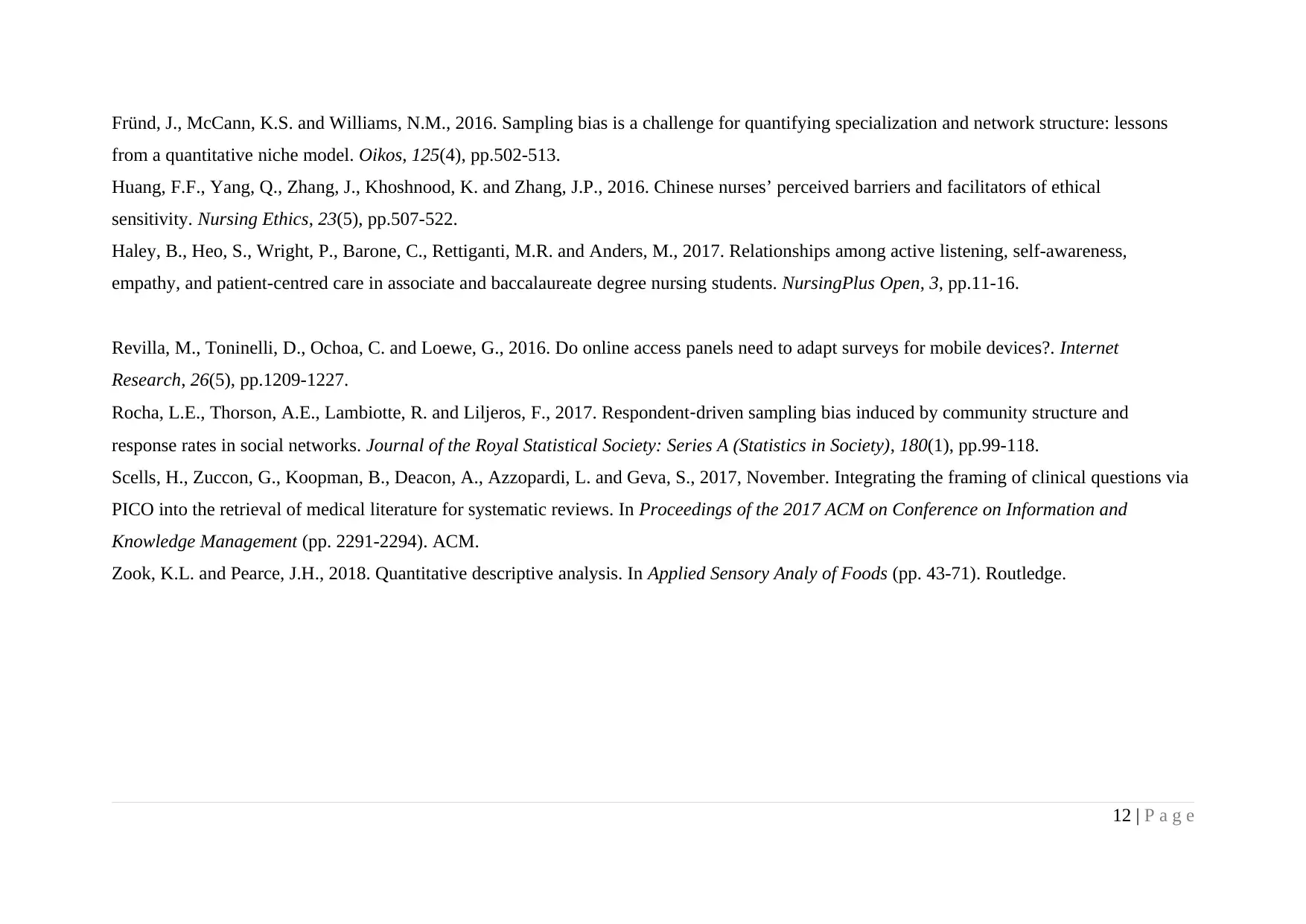
Fründ, J., McCann, K.S. and Williams, N.M., 2016. Sampling bias is a challenge for quantifying specialization and network structure: lessons
from a quantitative niche model. Oikos, 125(4), pp.502-513.
Huang, F.F., Yang, Q., Zhang, J., Khoshnood, K. and Zhang, J.P., 2016. Chinese nurses’ perceived barriers and facilitators of ethical
sensitivity. Nursing Ethics, 23(5), pp.507-522.
Haley, B., Heo, S., Wright, P., Barone, C., Rettiganti, M.R. and Anders, M., 2017. Relationships among active listening, self-awareness,
empathy, and patient-centred care in associate and baccalaureate degree nursing students. NursingPlus Open, 3, pp.11-16.
Revilla, M., Toninelli, D., Ochoa, C. and Loewe, G., 2016. Do online access panels need to adapt surveys for mobile devices?. Internet
Research, 26(5), pp.1209-1227.
Rocha, L.E., Thorson, A.E., Lambiotte, R. and Liljeros, F., 2017. Respondent‐driven sampling bias induced by community structure and
response rates in social networks. Journal of the Royal Statistical Society: Series A (Statistics in Society), 180(1), pp.99-118.
Scells, H., Zuccon, G., Koopman, B., Deacon, A., Azzopardi, L. and Geva, S., 2017, November. Integrating the framing of clinical questions via
PICO into the retrieval of medical literature for systematic reviews. In Proceedings of the 2017 ACM on Conference on Information and
Knowledge Management (pp. 2291-2294). ACM.
Zook, K.L. and Pearce, J.H., 2018. Quantitative descriptive analysis. In Applied Sensory Analy of Foods (pp. 43-71). Routledge.
12 | P a g e
from a quantitative niche model. Oikos, 125(4), pp.502-513.
Huang, F.F., Yang, Q., Zhang, J., Khoshnood, K. and Zhang, J.P., 2016. Chinese nurses’ perceived barriers and facilitators of ethical
sensitivity. Nursing Ethics, 23(5), pp.507-522.
Haley, B., Heo, S., Wright, P., Barone, C., Rettiganti, M.R. and Anders, M., 2017. Relationships among active listening, self-awareness,
empathy, and patient-centred care in associate and baccalaureate degree nursing students. NursingPlus Open, 3, pp.11-16.
Revilla, M., Toninelli, D., Ochoa, C. and Loewe, G., 2016. Do online access panels need to adapt surveys for mobile devices?. Internet
Research, 26(5), pp.1209-1227.
Rocha, L.E., Thorson, A.E., Lambiotte, R. and Liljeros, F., 2017. Respondent‐driven sampling bias induced by community structure and
response rates in social networks. Journal of the Royal Statistical Society: Series A (Statistics in Society), 180(1), pp.99-118.
Scells, H., Zuccon, G., Koopman, B., Deacon, A., Azzopardi, L. and Geva, S., 2017, November. Integrating the framing of clinical questions via
PICO into the retrieval of medical literature for systematic reviews. In Proceedings of the 2017 ACM on Conference on Information and
Knowledge Management (pp. 2291-2294). ACM.
Zook, K.L. and Pearce, J.H., 2018. Quantitative descriptive analysis. In Applied Sensory Analy of Foods (pp. 43-71). Routledge.
12 | P a g e
⊘ This is a preview!⊘
Do you want full access?
Subscribe today to unlock all pages.

Trusted by 1+ million students worldwide
1 out of 12
Your All-in-One AI-Powered Toolkit for Academic Success.
+13062052269
info@desklib.com
Available 24*7 on WhatsApp / Email
![[object Object]](/_next/static/media/star-bottom.7253800d.svg)
Unlock your academic potential
Copyright © 2020–2025 A2Z Services. All Rights Reserved. Developed and managed by ZUCOL.


